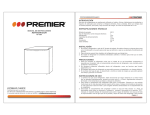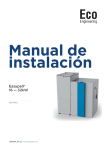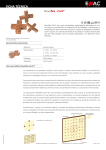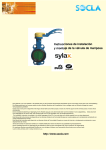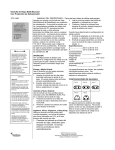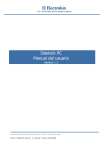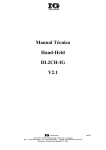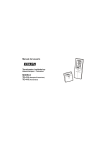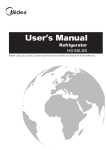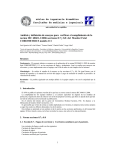Download NEVERA (FRIGO-BAR)
Transcript
MANUAL DE INSTRUCCIONES NEVERA (FRIGO-BAR) NV-1896 ESTIMADO CLIENTE Con el fin de que obtenga el mayor desempeño de su producto, por favor lea este manual de instrucciones cuidadosamente antes de comenzar a utilizarlo, y guárdelo para su futura referencia. Si necesita soporte adicional, no dude en escribir a: [email protected] PRECAUCIÓN RIESGO DE CHOQUE ELÉCTRICO , NO ABRA Precaución: Para reducir el riesgo de choque eléctrico, no retire la cubierta, no hay partes manipulables por el usuario al interior de la unidad. Refiera todo mantenimiento o intervención técnica a personal técnico calificado. Este símbolo indica la existencia de voltaje peligroso al interior de esta unidad, que constituye un riesgo de choque eléctrico. Este símbolo indica que hay importantes instrucciones de operación y mantenimiento en la literatura que acompaña a esta unidad. LÍNEAS DE SERVICIO AL CLIENTE PREMIER Venezuela: Panamá: Sitio Web: E-mail: 0800 – ELECTRIC (353-2874) 300-5185 www.premiermundo.com [email protected] NOTA Nos reservemos el derecho de modificar las especificaciones, características y/u operación de esta unidad sin previo aviso, con el fin de continuar las mejoras y desarrollo del mismo. Pagina 1 DESCRIPCIÓN GENERAL Este tipo de refrigerador es ampliamente utilizado en lugares como hoteles, oficinas, habitaciones de estudiantes y domicilios. Es adecuado para refrigerar y conservar alimentos como frutas y bebidas. Tiene la ventaja de poseer un tamaño compacto, es liviano y consume poca energía eléctrica, así mismo, es fácil de usar. ESPECIFICACIONES TÉCNICAS Potencia Tipo de protección contra choques eléctricos Refrigerante Volumen de almacenamiento Voltaje Frecuencia Clasificación climática 83 W I 32 g 50 L 115 V 60 Hz ST INSTALACIÓN 1. No incline el refrigerador a más de 45º cuando lo esté trasladando. No presione la zona del condensador, la puerta y otras piezas para evitar que se dañen, deformen o se vea afectado el funcionamiento del aparato. 2. Deje suficiente espacio libre alrededor del refrigerador para su correcto funcionamiento. 3. No lo instale en ambientes muy calientes o húmedos o donde pueda caerse o golpearse. INSTRUCCIONES DE SEGURIDAD 1. Antes de enchufar el refrigerador verifique que el voltaje de la red domiciliaria correspondoa con el requerimiento de voltaje del aparato. Debe enchufar el refrigerador en un tomacorriente independiente, ya que podría sobrecalentar el tomacorriente si usa un adaptador múltiple. 2. No almacene productos inflamables en el refrigerador, como bencina, gas licuado de petróleo, etc. 3. No salpique agua al refrigerador ya que podría dañarlo o provocar un choque eléctrico. 4. Si el gas se derrama de su contenedor no desenchufe el cable de energía ya que podría provocar chispas y ocasionar un incendio. INSTRUCCIONES DE USO 1. Cuando encienda el refrigerador por primera vez, déjelo funcionar sin nada adentro hasta que el compresor de detenga automáticamente una vez que alcance la temperatura deseada, lo que demora entre 2 a 3 horas. Seguidamente, ajuste la perilla del termostato a la temperatura que desee y coloque los alimentos dentro del refrigerador. 2. Para ajustar la temperatura del refrigerador gire la perilla del termostato. La temperatura media suele ser la más adecuada en la mayoría de los casos. Coloque el termostato en la posición “6” sólo si va a hacer cubitos de hielo o necesita congelar alimentos en la congeladora. 3. Descongele el congelador cuando la capa de hielo en la superficie del evaporador alcance 3 o 4mm de espesor. Para descongelar retire todos los alimentos y la cubitera y coloque el termostato en la posición “OFF”. Coloque la bandeja de goteo debajo del evaporador para recibir el agua descongelada. Una vez descongelado el hielo, vierta el agua acumulada y seque el interior del refrigerador. Seguidamente vuelva a colocar el termostato a la temperatura deseada. Pagina 2 4. Para preparar cubitos de hielo: Llene la cubitera de agua hasta debajo de la línea de nivel. Colóquela en el congelador y ajuste el termostato a la posición “6”. Los cubitos se formarán en 2 o 3 horas. Para sacar los cubitos de la cubitera, tuérzala suavemente. No la doble hacia arriba y abajo, pues podría romperla. PRECAUCIONES 1. Cuando abra la puerta del refrigerador, coloque o retire la mayor cantidad de alimentos posible, pues cada vez que abre la puerta aumenta el consumo de energía eléctrica y podría afectar el funcionamiento del refrigerador. 2. Es recomendable no colocar objetos muy pesados, puntiagudos o que puedan corroerse en las repisas. 3. Vuelva a enchufar el cable de energía después de 10 minutos. 4. No coloque botellas de vidrio dentro del congelador ya que podrían romperse y dañar el refrigerador. 5. Abra lo menos posible la puerta del refrigerador si se ha cortado la energía eléctrica. 6. No use objetos agudos o metálicos para remover el hielo cuando descongele el refrigerador ya que podría dañar el evaporador. 7. No toque los alimentos o recipientes que están dentro del congelador si tiene las manos húmedas ya que podría quemarse. MANTENIMIENTO 1. Desenchufe el cable de energía antes de limpiar el refrigerador. Use un paño humedecido en detergente neutro y enjuague con agua limpia. No use limpiadores abrasivos en polvo, paños tratados químicamente, thinner, alcohol, ácido, petróleo o agua caliente para limpiar el refrigerador ya que deteriorará la pintura y las cubiertas plásticas. 2. El sello hermético de la puerta se ensucia fácilmente, por lo que debe limpiarlo con regularidad. 3. Cuando no use el refrigerador por mucho tiempo, desenchufe el cable de energía, limpie y seque el interior del aparato y cierre bien la puerta. LOS SIGUIENTE SIGNOS NO REPRESENTAS AVERÍAS • SE OYE UN SONIDO DE AGUA CORRIENTE Este sonido es normal durante el funcionamiento del refrigerador. • CONDENSACIÓN EN EL EXTERIOR DEL REFRIGERADOR Es normal que se forme condensación en las paredes externas del refrigerador en ambientes húmedos. Simplemente seque la condensación. • EL REFRIGERADOR DEMORA EN ENFRIAR Si el termostato está en la posición máxima, en ambos compartimientos, demorará algún tiempo en alcanzar dicha temperatura. Si la temperatura ambiente es muy alta, demorará aún más tiempo. • EL COMPRESOR SE CALIENTA Es normal que el condensador se caliente durante el funcionamiento. No lo toque con las manos. Pagina 3 PROBLEMAS Y SOLUCIONES En caso de que haya algún desperfecto, revise la sigueinte tabla antes de solicitar servicio técnico. PROBLEMA No enfría No enfría bien • • • • • • • • • • Los alimentos se congelan en el • refrigerador. • • Ruidos • • El compresor no se detiene. • SOLUCIÓN Revise que haya energía eléctrica. Revise el voltaje. Revise el fusible o el disyuntor. Verifique que el cable de energía esté bien enchufado. Revise que el termostato esté en la posición adecuada. Verifique que haya suficiente espacio libre alrededor del refrigerador. Es posible que haya abierto la puerta con mucha frecuencia o durante mucho tiempo. Es posible que el refrigerador esté expuesto a la luz solar o cerca de fuentes de calor. Es posible que haya colocado demasiados alimentos. Es posible que haya colocado alimentos calientes. Revise que el termostato esté en la posición adecuada. Verifique que los alimentos no estén muy amontonados. Verifique que el refrigerador esté bien nivelado. Verifique que el refrigerador no esté chocando con otros objetos. Es posible que haya colocado demasiados alimentos a la vez. Es posible que haya abierto la puerta con mucha frecuencia o durante mucho tiempo. DIAGRAMA ELÉCTRICO Termostato Negro Azul Protector de sobrecalentamiento Verde Arranque PTC Blanco Pagina 4 Compresor Blanco INSTRUCTION MANUAL REFRIGERATOR (FRIGO-BAR) NV-1896 DEAR CUSTOMER In order to achieve the best performance of your product, please read this instruction manual carefully before using, and keep it for future reference. If you need extra support, please write to [email protected] CAUTION RISK OF ELECTRIC SHOCK, DO NOT OPEN Caution: To reduce the risk of electric shock do not open this device, there are not serviceable parts for customers. Please refer any maintenance or repair to qualified personnel. This sign means the existence of dangerous voltage at the inside of the unit, which states a risk of electric shock. This sign means that there are important instructions of operation and handling in the manual that comes with this device. PREMIER CUSTOMER SERVICE Venezuela: Panama: Website E-mail: 0800 – ELECTRIC (353-2874) 300-5185 www.premiermundo.com [email protected] NOTE This unit may be submitted to changes in specifications, characteristics and/or operation without prior notice to the user, in order to continue improving and developing its technology. P-1 GENERAL This type of refrigerator is widely used in places such as hotels ,offices, student dormitories and houses. It is mostly suitable for refrigerating and preserving foods such as fruits and beverage. It enjoys the advantages of small size, Lightweight, Low electric consumption and easy use. CHIEF TECHNICAL DATA Input Power Type of Preventing From Electric Shock Refrigerant Total Storage Volume Rated Voltage Rated Frequency Climatic Class 83 W I 32 g 50 L 115 V 60 Hz ST Instructions for Installation 1.Do not tilt the refrigerator for more than 450 form upright during moving it. And do not apply force on any part such as condenser and door to prevent the refrigerator from deforming, or else it will influence its performance. 2.Let the refrigerator have enough space to work well. 3.Don’t install it in high temperature of humidity place so as to avoid being damaged, dampened and rusted. Cautions for Safety 1.Before the refrigerator is plugged in check in the electric voltage to be used fit is the same as the rated voltage. The power plug should have its independent socket, adapter may cause the socket overheat. 2.Don’t store inflammable materials such as ether, benzine, LP gas and glue etc in the refrigerator. 3.Don’t splash water on the refrigerator, it may arouse malfunction or electric shock. 4.When gas leaks from its container. Don’t pull the plug out or in. it may arose sparks and fire calamities. Instructions for Use 1.When operating the refrigerator for the first time, run it without loading any food until it autos tops at the desired temperature. Usually it takes 2 or 3hours,then set the thermostatic dial at the setting desired and put foods in the refrigerator. 2.The temperature of the refrigerator can be adjusted by turning the thermostatic dial. A medium setting of the thermostatic dial is the most suitable for general operation. Set the thermostat at “6” position only when ice cubes are made or frozen food are stored in the freezing compartment. 3.Defrost the freezing compartment whenever the layer of frost on the surface of the evaporator reaches 3 or 4 mm. When defrosting remove all food and ice cube tray and set the thermostat at “OFF” position. Put the drip tray under the evaporator to collect melted water. After the frost has melted, discard the melted water and dry up the interior of refrigerator. The refrigerator can then be restarted by turning its thermostat to the desired setting. 4.Instruction for making and removing pieces of ice cube. Fill water into the ice making case below the graduated line, put it into the freezing compartment, and then set the thermostat at “6” position. It takes about 2 or 3 hours to make ice cubes. Pieces of ice cube can be removed by twisting the ice making case. Don’t cut up and down, otherwise it may be P-2 broken. CAUTIONS FOR USE 1.The more foods tuff put in or the more and the longer for once the door is opened, the more it needs electric consumption, which even leads malfunction. 2.Better not to place the objects which are too heavy ,pointed or corrosion on table board. 3.Re-plugging in the power plug at the interval of over ten minutes. 4.Don’t store bottled drink in the freezer, so as to prevent from being broken and damaging the refrigerator. 5.Open the door as less as possible during power-cut. 6.When defrosting, never use any sharp or metallic objects to remove the frost on the surface of the evaporator as it will damage the evaporator. 7.Don’t touch foods and containers in the freezing compartment with your wet hands so as to prevent from being frostbitten. MAINTENANCE 1.While cleaning the refrigerator. pull out the electric power plug, rub carefully with a piece of cloth soaked with natural cleanser then wipe with clean water. The abrasive cleaning power, alkali cleansers, chemical cloth, thinner, alcohol, acid petroleum product and hot water are not suitable for cleaning the refrigerator, they may damage the painting cover and plastics. 2.The door gasket is dirty and fogged easily, so clean it frequently. 3.If the refrigerator is out of use for a long time, please pull out the plug, clean and dry the freezing compartment then close the door tightly. THE FOLLOWING CASES ARE NOT MALFUNCTION 1.A flowing water sound: Flowing water sound will be heard under normal operation. 2.Outside condensation: Outside condensation is normal in high humidity condition. You may just wipe it up yourself. 3.It takes some times for the temperature of the freezer and refrigerator compartments to become cold after the refrigerator starts to operate: If the temperature of the two compartments is higher while the refrigerator is operating, it takes some times for the temperature of the two compartments to become cold. If the environmental temperature is higher, it takes a long time to make the compartments to become cold. 4. The surface of the compressor becomes hot: The surface of the compressor may become hot under normal operation. Don’t touch it with hands. P-3 METHODS OF INSPECTING MALFUNCTION If any case of malfunction happens, please inspect and dispel it according to the methods shown in the following table. CASE Not refrigerating Not efficient Food frozen in the refrigerator Compartment Noises Compressor Cannot stop automatically CIRCUIT DIAGRAM P-4 • • • • • • • • • • • • • • • • INSPECTION Is there no electric current. Is the voltage normal or not. Has the socket fused. Has the plug been put in effectively. Is the thermostatic dial set to the correct position. Is there any suitable clearance surrounding the refrigerator. Has the door been opened too frequently or too long. Is the refrigerator exposed to sunlight directly or placed near some heating devices. Are there too much food inside. Or are too hot. Is the thermostatic dial set to the correct position. Have the foods stuff been put too crowded. Is the refrigerator installed firmly. Has the refrigerator been struck by some other objects. Are the foods stored too much at one setting. Are the doors opened too frequently or too long.











